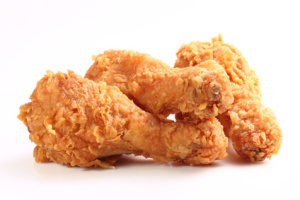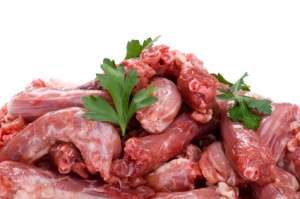We all know how to describe our food, right? Chocolate is sweet. Lemons are sour. Fresh cranberries are bitter. French fries are salty. These words are part of our everyday vocabulary, and these basic tastes make up the language we use to both create our meals and recipes and talk about our food.
But did you know there is a fifth taste?
It’s true! Umami (pronounced ooo-MOM-ee) is the word for that flavor we’ve always been able to taste but have never been able to quite describe. Umami is, according to the Umami Information Center, “a pleasant savory taste imparted by glutamate, a type of amino acid, and ribonucleotides, includes inosinate and guanylate, which occur naturally in many foods including meat, fish, vegetables and dairy products.” Umami, in short, is the taste of protein. And it’s delicious.
Umami is a Japanese word (it stems from the word “umai,” which means delicious), but it’s a taste beloved worldwide. This map of traditional, umami-rich foods from around the world demonstrates that umami is a taste sought by every culture, from seafood-based sources in Asia to Hungarian-style kielbasa and aged cheeses in Europe to some downhome BBQ sauce and gravy in the U.S. One of the most commonly enjoyed sources of umami around the world is actually tomatoes. Think about how many variations there are on the tomatoes from your backyard garden—marinara sauce, ketchup, a slice on your hamburger, mole sauce…the list goes on. Tomatoes are a cooking staple in part because they are such an amazing source of umami.

Okay, so pretty much everyone loves umami. Why, though?
Well, it comes down to biology. Humans are drawn toward things that are necessary to our survival. Protein is one of those things, and if you’re tasting umami, it means you are consuming the protein your body needs to function. Umami is actually more than just a taste, though. Umami helps satisfy your appetite, which in turn, helps control portion size. It also decreases the need for salt in your food. Umami enhances salt’s flavor so you don’t need to use as much to achieve the same result.
How can you tell how much umami you might get from a given food? Umami can be measured by the level of free glutamatic acid in the food. Aged cheddar cheese has an umami level of 78 mg/100g. Parmesan cheese, on the other hand, is one of the most umami-rich foods around with a level of 1,680! There are many foods that contain umami and you can use your taste buds to guide you toward your favorite combinations or check out this chart for the specific levels.
You may be wondering why, if umami is such an essential part of cuisine, you haven’t heard of it before. Umami is a taste humans have craved for thousands of years, and the term “umami” was coined back in 1908 by a chemist named Kikunae Ikeda (who went on to patent MSG). However, umami has only recently been recognized by western scientists—the existence of taste receptors on our tongues for umami, in addition to the four basic tastes of sweet, sour, bitter, and salty, was just confirmed in 2009.

Science has also shown that the math behind umami’s flavor isn’t as simple as 1+1=2. Instead, when ingredients with umami-providing compounds are combined (like beef and cheese), the ingredients enhance each other and increase the umami exponentially, creating flavorful, crave-worthy dishes. You may already be maximizing your meals’ umami potential without even realizing it. Bacon on a hamburger? Parmesan on top of your tomato sauce and pasta? Peak umami. But if you’re looking to deliberately try for that delicious umami taste, there are a ton of options you can try out—and most of the ingredients are probably already in your kitchen.
- A dash of fish sauce (made from fermented fish and packed with umami) will give a dish an added layer of flavor
- Try boiling your potatoes in chicken broth rather than water
- Add red wine to soups or stews
- Pair beef with mushrooms or mushroom sauce
- Add this brown sugar cured Berkshire bacon to literally everything
- Toss some cooked shrimp into your salad
In the mood for a foolproof umami recipe rather than some umami flavor experimentation? There are a ton of umami-rich recipes to choose from, and the recent emphasis on umami and all its glory means a quick Google search will bring up galleries of umami-laden recipes. As you browse, you’ll probably notice that a lot of the recipes are classic comfort foods—just another sign that we all love and instinctively seek out umami!
Here a few highlights from Eating Well’s umami gallery:
- Lasagna with Slow-Roasted Tomato Sauce (umami elements: tomatoes, mozzarella, ricotta, Parmesan)
- Blue Cheese Portobello Burger (umami elements: mushroom, ruby port, blue cheese, tomato)
- Baked Parmesan Tomatoes (umami elements: you guessed it—tomatoes and Parmesan. A quick and easy side dish!)
Want to try something a little more unusual? Try this Japanese Beef Stew recipe. It’s packed with umami and features beef chuck roast, which you can stock up on right here.
Whatever flavor you’re craving today—be it sweet, sour, bitter, salty, or umami—we wish you a day of delicious, satisfying meals.
Enjoy!



 st friend. Often pre-cooked and able to be served hot or cold, ham is perfect for stress-free feeding of a big crowd.)
st friend. Often pre-cooked and able to be served hot or cold, ham is perfect for stress-free feeding of a big crowd.) common wet curing mixtures are brine (salt and water) and sweet pickle (salt, water, and sugar). You can also add additional flavorings, such as rosemary or garlic, to the mix before either injecting the ham with the mixture or submerging it for up to a week.
common wet curing mixtures are brine (salt and water) and sweet pickle (salt, water, and sugar). You can also add additional flavorings, such as rosemary or garlic, to the mix before either injecting the ham with the mixture or submerging it for up to a week.

 Table salt got its name from the place you find it most, on the table in cute little salt shakers (like the one shown here). It’s procured by pumping water into underground deposits to dissolve the salt, bringing the brine to the surface, settling out the impurities and then evaporating the crystals out. This process yields the tiny, regularly shaped grains (that are able to fit through your salt shaker!)
Table salt got its name from the place you find it most, on the table in cute little salt shakers (like the one shown here). It’s procured by pumping water into underground deposits to dissolve the salt, bringing the brine to the surface, settling out the impurities and then evaporating the crystals out. This process yields the tiny, regularly shaped grains (that are able to fit through your salt shaker!)
 Some important points we’ve discussed:
Some important points we’ve discussed:
 The knife our lucky winner will receive was tops in all these categories and should provide a lifetime of perfect slicing!!
The knife our lucky winner will receive was tops in all these categories and should provide a lifetime of perfect slicing!!


















